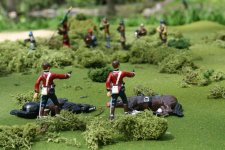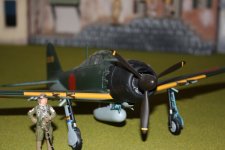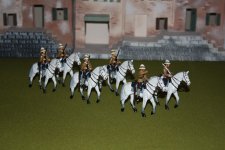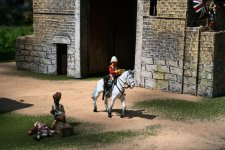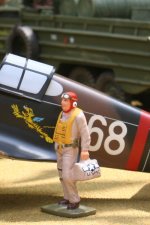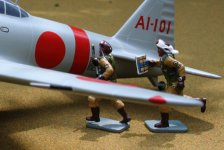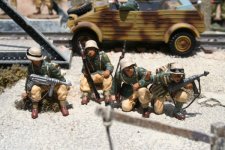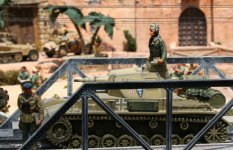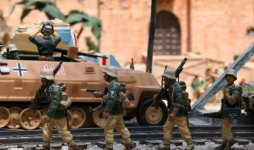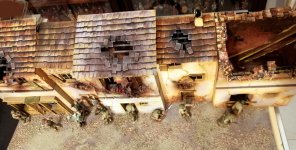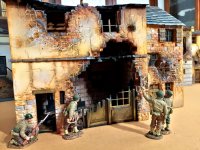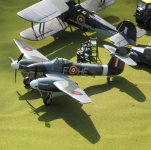You are using an out of date browser. It may not display this or other websites correctly.
You should upgrade or use an alternative browser.
You should upgrade or use an alternative browser.
K&C photographs (2 Viewers)
- Thread starter panda1gen
- Start date
bromhead
Sergeant Major
- Joined
- Aug 7, 2008
- Messages
- 1,712
I love "glossies". They are my definition or charming.
But wait - I love the new stuff too... and that's one awesome warbird.
Thanks for the post and viva la glossies.
Paddy
i agree,,,my latest restored old figures i enjoy doing in gloss,,
bromhead
Sergeant Major
- Joined
- Aug 7, 2008
- Messages
- 1,712
Kevin,
I want to thank you for all of the great memories your wonderful photos evoke!:salute:: None of the many friends who are still with us (unlike the late Larry Lo, Chuck Karen and so many of our friends) who participated will ever forget those amazing photos sessions!
nice but that huey natl insignia would have been ib black
RISORGIMENTO
Sergeant Major
- Joined
- Sep 28, 2010
- Messages
- 1,541
RISORGIMENTO
Sergeant Major
- Joined
- Sep 28, 2010
- Messages
- 1,541
Louis Badolato
Lieutenant General
- Joined
- Apr 25, 2005
- Messages
- 18,421
Kevin,Louis - as discussed - early morning mist as General Lee acknowledges his wounded soldiers ...
View attachment 303603
That was such a perfect morning for that photo shoot, with the mist coming off my neighbor's pond. :salute::
RISORGIMENTO
Sergeant Major
- Joined
- Sep 28, 2010
- Messages
- 1,541
panda1gen
Colonel
- Joined
- Jul 29, 2005
- Messages
- 8,103
Westland Whirlwind - Edited from Wikipedia

The performance of its Peregrine engines fell off at altitude, so the Whirlwind was most often used in ground-attack missions over France, attacking German airfields, marshalling yards, and railway traffic.
The Whirlwind was used to particularly good effect as a gun platform for destroying locomotives. Some pilots were credited with several trains damaged or destroyed in a mission.
The aircraft was also successful in hunting German E boats in the English Channel.
At lower altitudes, it could hold its own against the Messerschmitt Bf 109. Though the Peregrine was a much-maligned engine, it was more reliable than the troubled Napier Sabre engine used in the Hawker Typhoon, the Whirlwind's successor.
The twin engines meant that seriously damaged aircraft were able to return with one engine knocked out. The placement of the wings and engines ahead of the cockpit allowed the aircraft to absorb a great deal of damage, while the cockpit area remained largely intact. The rugged frame of the Whirlwind gave pilots greater protection than contemporary aircraft during crash landings and ground accidents.
According to P. J. R. Moyes -
Initial operations consisted of convoy patrols and anti E-boat missions. The Whirlwind's first confirmed kill occurred on 8 February 1941, when an Arado Ar 196 floatplane was shot down; the Whirlwind responsible also crashed into the sea and the pilot was killed.
From then on the squadron was to have considerable success with the Whirlwind while flying against enemy Junkers Ju 88, Dornier Do 217, Messerschmitt Bf 109s and Focke-Wulf Fw 190s.
263 Squadron also occasionally carried out day bomber escort missions with the Whirlwinds. The squadron mostly flew low-level attack sorties across the channel ("Rhubarbs" against ground targets and "Roadstead" attacks against shipping).
The Whirlwind proved a match for German fighters at low level, as demonstrated on 6 August 1941, when four Whirlwinds on an anti-shipping strike were intercepted by a large formation of Messerschmitt Bf 109s and claimed three Bf 109s destroyed for no losses. A second Whirlwind squadron was formed in September 1941, specialising in attacks against railway targets.
In the summer of 1942, both squadrons were fitted with racks to carry two 250 or 500 lb (110 or 230 kg) bombs, and nicknamed 'Whirlibombers'. These undertook low-level cross-channel "Rhubarb" sweeps, attacking locomotives, bridges, shipping and other targets.
The worst losses of 137 Squadron occurred on 12 February 1942 when they were sent to escort five British destroyers, unaware of the escaping German warships Scharnhorst and Gneisenau making the Channel Dash to safer ports. Four of eight Whirlwinds failed to return.
From 24 October until 26 November 1943, Whirlwinds of 263 Squadron made several heavy attacks against the German blockade runner Münsterland, in dry dock at Cherbourg. As many as 12 Whirlwinds participated at a time in dive bombing attacks carried out from 12,000–5,000 ft (3,700–1,500 m) using 250 lb (110 kg) bombs. The attacks were met by very heavy anti-aircraft fire but virtually all bombs fell within 500 yd (460 m) of the target; only one Whirlwind was lost during the attacks.
The last Whirlwind mission to be flown by 137 Squadron was on 21 June 1943, when five Whirlwinds took off on a "Rhubarb" attack against the German airfield at Poix. P6993 was unable to locate the target and instead bombed a supply train north of Rue. It later made a forced landing in a field next to RAF Manston, the aircraft was a write-off, although, as in many other crash landings, the pilot walked away unhurt.
No. 263 Squadron was the first and last squadron to operate the Whirlwind. It flew its last Whirlwind mission on 29 November 1943, converting to the Hawker Typhoon in December 1943.
On 1 January 1944, the type was declared obsolete.
Bearing in mind the relatively small number of Whirlwinds that reached the RAF, the type remained in combat service, virtually unmodified, for a remarkably long time. The Whirlwind, once mastered, shouldered extensive responsibilities and the two squadrons attacked enemy targets from one end of the Channel to the other, by day and night, by moving from airfield to airfield within southern England.

The performance of its Peregrine engines fell off at altitude, so the Whirlwind was most often used in ground-attack missions over France, attacking German airfields, marshalling yards, and railway traffic.
The Whirlwind was used to particularly good effect as a gun platform for destroying locomotives. Some pilots were credited with several trains damaged or destroyed in a mission.
The aircraft was also successful in hunting German E boats in the English Channel.
At lower altitudes, it could hold its own against the Messerschmitt Bf 109. Though the Peregrine was a much-maligned engine, it was more reliable than the troubled Napier Sabre engine used in the Hawker Typhoon, the Whirlwind's successor.
The twin engines meant that seriously damaged aircraft were able to return with one engine knocked out. The placement of the wings and engines ahead of the cockpit allowed the aircraft to absorb a great deal of damage, while the cockpit area remained largely intact. The rugged frame of the Whirlwind gave pilots greater protection than contemporary aircraft during crash landings and ground accidents.
According to P. J. R. Moyes -
The basic feature of the Whirlwind was its concentration of firepower: its four closely-grouped heavy cannon in the nose had a rate of fire of 600 lb./minute – which, until the introduction of the Beaufighter, placed it ahead of any fighter in the world. Hand in hand with this dense firepower went a first-rate speed and climb performance, excellent manoeuvrability, and a fighting view hitherto unsurpassed. The Whirlwind was, in its day, faster than the Spitfire down low and, with lighter lateral control, was considered to be one of the nicest "twins" ever built… From the flying viewpoint, the Whirlwind was considered magnificent.[SUP]
[/SUP]
The first Whirlwind squadron would be 263 Squadron, which was reforming at RAF Grangemouth, after disastrous losses in the Norwegian Campaign. The first production Whirlwind was delivered to 263 Squadron by its commander, Squadron Leader H. Eeles on 6 July. Deliveries were slow, with only five on strength with 263 Squadron on 17 August 1940 and none serviceable. (The squadron supplemented its strength with Hawker Hurricanes to allow the squadron's pilots to fly in the meantime.) No. 263 Squadron moved south to RAF Exeter and was declared operational with the Whirlwind on 7 December 1940. [/SUP]

Initial operations consisted of convoy patrols and anti E-boat missions. The Whirlwind's first confirmed kill occurred on 8 February 1941, when an Arado Ar 196 floatplane was shot down; the Whirlwind responsible also crashed into the sea and the pilot was killed.
From then on the squadron was to have considerable success with the Whirlwind while flying against enemy Junkers Ju 88, Dornier Do 217, Messerschmitt Bf 109s and Focke-Wulf Fw 190s.
263 Squadron also occasionally carried out day bomber escort missions with the Whirlwinds. The squadron mostly flew low-level attack sorties across the channel ("Rhubarbs" against ground targets and "Roadstead" attacks against shipping).
The Whirlwind proved a match for German fighters at low level, as demonstrated on 6 August 1941, when four Whirlwinds on an anti-shipping strike were intercepted by a large formation of Messerschmitt Bf 109s and claimed three Bf 109s destroyed for no losses. A second Whirlwind squadron was formed in September 1941, specialising in attacks against railway targets.
In the summer of 1942, both squadrons were fitted with racks to carry two 250 or 500 lb (110 or 230 kg) bombs, and nicknamed 'Whirlibombers'. These undertook low-level cross-channel "Rhubarb" sweeps, attacking locomotives, bridges, shipping and other targets.
The worst losses of 137 Squadron occurred on 12 February 1942 when they were sent to escort five British destroyers, unaware of the escaping German warships Scharnhorst and Gneisenau making the Channel Dash to safer ports. Four of eight Whirlwinds failed to return.
From 24 October until 26 November 1943, Whirlwinds of 263 Squadron made several heavy attacks against the German blockade runner Münsterland, in dry dock at Cherbourg. As many as 12 Whirlwinds participated at a time in dive bombing attacks carried out from 12,000–5,000 ft (3,700–1,500 m) using 250 lb (110 kg) bombs. The attacks were met by very heavy anti-aircraft fire but virtually all bombs fell within 500 yd (460 m) of the target; only one Whirlwind was lost during the attacks.
The last Whirlwind mission to be flown by 137 Squadron was on 21 June 1943, when five Whirlwinds took off on a "Rhubarb" attack against the German airfield at Poix. P6993 was unable to locate the target and instead bombed a supply train north of Rue. It later made a forced landing in a field next to RAF Manston, the aircraft was a write-off, although, as in many other crash landings, the pilot walked away unhurt.
No. 263 Squadron was the first and last squadron to operate the Whirlwind. It flew its last Whirlwind mission on 29 November 1943, converting to the Hawker Typhoon in December 1943.
On 1 January 1944, the type was declared obsolete.
Bearing in mind the relatively small number of Whirlwinds that reached the RAF, the type remained in combat service, virtually unmodified, for a remarkably long time. The Whirlwind, once mastered, shouldered extensive responsibilities and the two squadrons attacked enemy targets from one end of the Channel to the other, by day and night, by moving from airfield to airfield within southern England.
panda1gen
Colonel
- Joined
- Jul 29, 2005
- Messages
- 8,103
Beautiful layout and impressive airplane, both model and real world performance.
Mark
Thanks, Louis should get the credit as this set up was all from the Badolato collection, in Louis' back yard, for the book we did.
Beaufighter
Sergeant Major
- Joined
- Apr 12, 2006
- Messages
- 1,743
Kevin,
Thanks for bringing the Whirlwind to the forefront! She definitely does not get the visible credit that she earned. Seeing your pictures makes me regret not adding that aircraft to my collection. As always, your scale historical photo journalism is much appreciated and All-Pro in my book.
Check Six & Be Well,
Marc/Beaufighter
Thanks for bringing the Whirlwind to the forefront! She definitely does not get the visible credit that she earned. Seeing your pictures makes me regret not adding that aircraft to my collection. As always, your scale historical photo journalism is much appreciated and All-Pro in my book.
Check Six & Be Well,
Marc/Beaufighter
panda1gen
Colonel
- Joined
- Jul 29, 2005
- Messages
- 8,103
Kevin,
Thanks for bringing the Whirlwind to the forefront! She definitely does not get the visible credit that she earned. Seeing your pictures makes me regret not adding that aircraft to my collection. As always, your scale historical photo journalism is much appreciated and All-Pro in my book.
Check Six & Be Well,
Marc/Beaufighter
Thanks Marc,
Remember this? Should we give the Mossie the same treatment?
Kevin
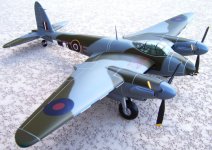
Louis Badolato
Lieutenant General
- Joined
- Apr 25, 2005
- Messages
- 18,421
Thanks, Louis should get the credit as this set up was all from the Badolato collection, in Louis' back yard, for the book we did.
Kevin acted as art director as well as photographer and deserves the lion's share of the credit. :salute:: As he once put it, all I did was sit on my *** up and down the stairs all day carrying the figures, aircraft, vehicles and diorama materials. I worked, he worked magic.
Beaufighter
Sergeant Major
- Joined
- Apr 12, 2006
- Messages
- 1,743
Thanks Marc,
Remember this? Should we give the Mossie the same treatment?
Kevin
View attachment 303609
Right On Kevin! I sure do. Truth be told the dh98 is my favorite plane closely followed by the Beaufighter & Corsair! Thanks for the memory.
panda1gen
Colonel
- Joined
- Jul 29, 2005
- Messages
- 8,103
Right On Kevin! I sure do. Truth be told the dh98 is my favorite plane closely followed by the Beaufighter & Corsair! Thanks for the memory.
Edited from Wikipedia - Early wooden K&C Beaufighter
The Bristol Type 156 Beaufighter (often called the Beau) is a British multi-role aircraft developed during the Second World War by the Bristol Aeroplane Company. It was originally conceived as a heavy fighter variant of the Bristol Beaufort torpedo bomber.
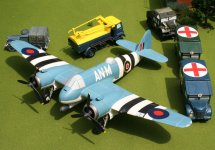
The Beaufighter proved to be an effective night fighter, which came into service with the Royal Air Force (RAF) during the Battle of Britain, its large size allowing it to carry heavy armament and early airborne interception radar without major performance penalties.
The Beaufighter was used in many roles; receiving the nicknames Rockbeau for its use as a rocket-armed ground attack aircraft and Torbeau as a torpedo bomber against Axis shipping, in which it replaced the Beaufort.

In later operations, it served mainly as a maritime strike/ground attack aircraft, RAF Coastal Command having operated the largest number of Beaufighters amongst all other commands at one point.
 Coastal Command version
Coastal Command versionThe Royal Australian Air Force (RAAF) also made extensive use of the type as an anti-shipping aircraft, such as during the Battle of the Bismarck Sea.
The Beaufighter saw extensive service during the war with the RAF (59 squadrons), Fleet Air Arm (15 squadrons), RAAF (seven squadrons), Royal Canadian Air Force (four squadrons), United States Army Air Forces (four squadrons), Royal New Zealand Air Force (two squadrons), South African Air Force (two squadrons) and Polskie Siły Powietrzne (Free Polish Air Force; one squadron).
Variants of the Beaufighter were manufactured in Australia by the Department of Aircraft Production (DAP); such aircraft are sometimes referred to by the name DAP Beaufighter.
Users who are viewing this thread
Total: 2 (members: 0, guests: 2)


